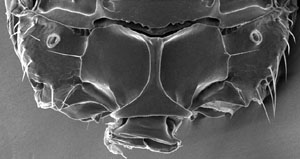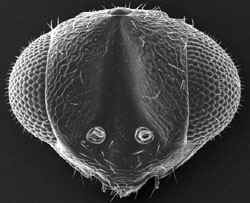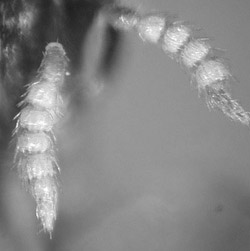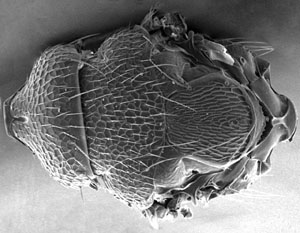

Grotiusomyia propodeum (left), and face (right)
return to: Eul 1 Eul 4 ent 1 eud 1 cir1 eul 1 eul 5 eul 10 eul 14 eul 17 eul 20 eul 24 eul 27
Grotiusomyia
Girault, 1917 comparative info return to: prev(eul 8) prev(eul
19) home
Clypeal margin distinctly convex, with tiny flange-like ventral margin. 4
funicular segments, all funicular segments, except 1st
funicular segment in some species, quadrate or broader than long; males
with asymmetrical funicular segments similar to those in Paraolinx. Faint
occipital carina present near ocelli. Notauli faintly complete, sometimes obscured by the
strong mesoscutal sculpture; scutellum strongly reticulate, sublateral
grooves absent anteriorly, present posteriorly, curving to meet near scutellar
apex. Median carina of propodeum strong; median panels sharply raised above
supracoxal flange and lateral areas of propodeum; lateral edge of raised
area with 1 seta on each side (distinct from callar setae). Compare with: Paraolinx.


Grotiusomyia propodeum (left), and face (right)


Grotiusomyia female antennae (left), and mesosoma (right)
Biology: Parasitoids of pyralids on Quercus and Populus.
Comments: 2 described species. Widespread but very rarely collected genus.
Comparative information:
Paraolinx: Scutellar grooves completely absent. Median panels of propodeum not raised above lateral and posterior areas, often undifferentiated. Mandibles relatively elongate, with numerous tiny denticles.
References
Boucek, Z. 1977. Descriptions of two new species of Neotropical Eulophidae (Hymenoptera) of economic interest, with taxonomic notes on related species and genera. Bulletin of Entomological Research. 67(1): 1-15.
LaSalle, J. & M.E. Schauff. 1992. Preliminary studies on Neotropical Eulophidae (Hymenoptera: Chalcidoidea): Ashmead, Cameron, Howard, and Walker species. Contributions of the American Entomological Institute 27.